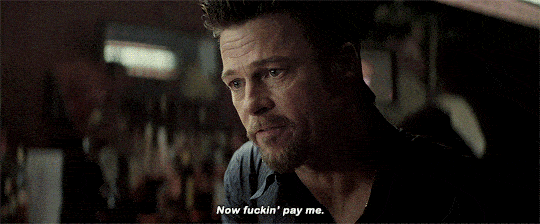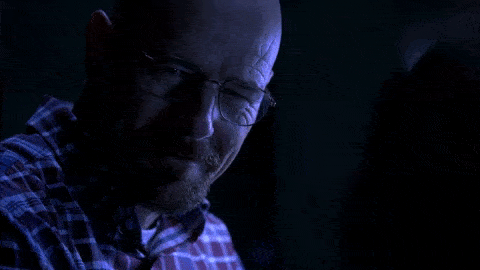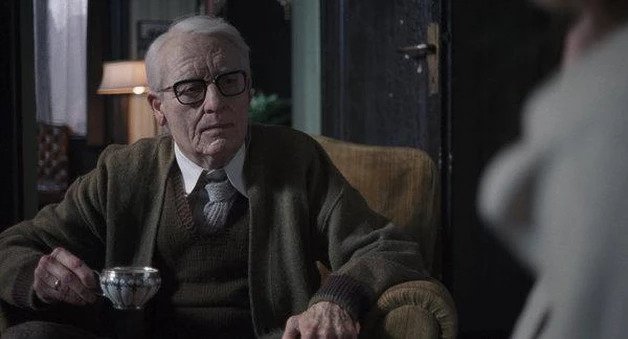The 2018 incarnation of Suspiria is, weirdly enough, a condemnation of leaders and political figures who abuse their power. It just so happens to explore that topic in an unexpected way—by following witches running a dance school. Because so much of what Suspiria’s doing is symbolic in order to make a thematic point, the story can be hard to figure out when you look only at the face value of the plot. But once you get the point, Suspiria is, you’ll be relieved to hear, actually pretty simple.
This isn’t unheard of. You maybe remember a little ditty called Killing Them Softly. How people went into Suspiria expecting straight horror, people went into Killing Them Softly expecting a gangster film. And some gangster stuff does happen! Following a couple low-lifes robbing a poker game attended by high-level mobsters, businessmen, and politicians, Brad Pitt is hired to “make things right”. Meaning Pitt finds the low-lifes involved and kills them. But the process is slow, as the movie constantly dips into extended conversations about the socio-political environment of 2008. Those asides left people scratching their heads. For example, why have an entire 20-minute section with James Galdolfini where he’s just depressed and rambling about how his life has gone downhill?
It turns out, Killing Them Softly isn’t really a gangster movie at all! Rather, it’s a fictional retelling of the 2008 financial crisis but done in the style of a gangster movie. The poker game is the economy. The low-lifes who rob it are the irresponsible bankers who created then burst the housing bubble. Characters like James Gandolfini are emblematic of how the economic downturn ruined lives. Brad Pitt represents the capitalistic spirit of America. Which is why at the end there’s a TV with Obama’s inauguration speech in the background and Brad Pitt giving a speech about Thomas Jefferson and America and how America is just a business and concludes the movie by saying, “Now fucking pay me.”
Show It
It’s easy to tell someone something rather than show them.
For example, how simple is it to say, “Political maneuvering often leads to political incivility which leads to innocent people being hurt. And those people who were hurt often feel more guilt about it all than the people who caused the pain.”
Nothing to it!
It’s quite another exercise to show how political maneuvering often leads to political incivility which leads to innocent people being hurt and how those who were hurt often feel more guilt about it all than the people who caused the pain—to show all of that takes way more time and effort.
Think about a game of charades. If you have to charade Breaking Bad…how do you go about that? You can’t use quotes. You can’t give vague descriptions. What do you do? You need to demonstrate. How do you demonstrate something conceptually multi-faceted and complex?
Typically, movies that tell are more straightforward because they explain everything. Movies that show are far less straightforward as they’re charades-ing everything. For Suspiria, it has to show: political maneuvering; political maneuvering leading to political incivility; innocents being hurt by political incivility; people who were hurt feeling guilt; people who caused the pain not feeling guilt. With all that on the plate, Suspiria of course takes longer to play out, resulting in a run time of 152 minutes. It also uses another technique: contextual references.
Cite Your References
Killing Them Softly opens in a weird tunnel leading to a wasted industrial environment. That in and of itself is visually meaningful, but is non-contextual to anything in the real world. To make a real world connection to a specific time and a specific place, Killing Them Softly adds a voiceover of Obama’s post-2008-election speech. Upon first watch, that choice might not make a lot of sense to a viewer. But after the movie’s over, as we try to figure out why and what and how…that opening speech is a huge blinking neon sign. One of many clues that add up to the thematic intent of the film.
Suspiria has its share of these blinking neon signs. For example, the setting is 1977 and the German Autumn. We have references to World War II, the wall dividing Berlin, Nazis, and the Red Army Faction/Baader-Meinhof Gang (the plane hijacking that plays out during Suspiria really happened). The film could have used anything to define the time and place. Showcasing these political elements was purposeful to add the German political context to the story of the witches.
Politics is Politics is Politics
It’s after the German political context is brought into Suspiria that we’re introduced to the political strife of the witches. They have a vote for who will be the leader: Blanc or Markos. Markos wins, but here’s the thing about Markos. She wins not because she’s the best leader. But because she’s convinced some of the others she’s the reincarnation of Mother Suspiriorum. All Markos needs is a new body, and she’ll be restored to all her former glory! In order to get Markos what she needs, the witches have to hold a ceremony where they transfer Markos’s spirit into the body of one of the dancers. The machinations of this transfer make up the bulk of the movie plot.
We discover Markos was a big fat liar. To avoid dying or at least living in the decrepit body she had, Markos lied about being Mother Suspiriorum as she knew it would give her power and motivate others to ensure she got a new body and could live on. In the name of Markos, the witches do some petty shit. They brutalize their students. They fight amongst themselves. One even commits suicide. They fuck with poor old Dr. Klemperer. Their big dance performance gets ruined and terrifies the public who came to watch. Their bullshit draws the attention of the police, then they dick around with the police. On the one hand, it makes sense witches are up to some weird shit. On the other hand, it’s done in support of a liar. Through the motivations of a false idol.
When you see the disruptions to witch society Markos’s agenda has caused, it’s not hard to draw comparisons to the German political context. Like to…the Nazis in the 1940s. Or an unstable post-Nazi Berlin. Look at the problems the Red Army Faction causes everyone who just wants to live their goddamn life in peace. Bombings. The plane highjacking. Innocent people suffer when this shit happens.
The Witness
The most innocent character Suspiria presents to us is Dr. Klemperer. Dude gets dragged into everything because he was Patricia’s therapist. He’s concerned about her and does his due diligence in trying to figure out what happened to her. Because of him being a decent, normal person…look at what happens to him. First he spends time stressing over Patricia. Then he’s told by Sara there’s a legit conspiracy going on. Then the witches fuck with Klemperer by convincing him he’s reunited with the wife he believed he lost during the Holocaust 30 years before. Then he’s captured, stripped naked, and made to bear witness to the witch-rebirth ceremony. Which involves all the horror of the ceremony itself, seeing what happened to Patricia and Sara, Susie’s reveal, the demon, all the blood, etc.
Klemperer witnesses as much as he does for a reason: Suspiria needs to wreck him. The character exists as a symbol of the many who are the collateral damage of political incivility. With his backstory being he was a victim of the Nazis seizing power, Klemperer’s character becomes a bridge between the German political context and the non-contextual world of the witches.
If only the Nazis were used, then the connection would be a bit more one dimensional: the witches are akin to Nazis. Similar to the symbolism of the Death Eaters and Voldemort in Harry Potter. But because Suspiria sets itself during the German Autumn, the message isn’t really that the witches are Nazis so much as that the witches, Nazis, and Red Army Faction are all one and the same: disruptive, uncivil, selfish political groups that harm innocent people and can vary in shape, size, and purpose.
Utopia
Suspiria spends most of its run-time in pretty dystopian settings. Germany is not at its best, and neither is the Markos Dance Academy. But the point of Suspiria isn’t to just to reflect on how politics can compromise society. If that was the case, then the movie would have ended in a far bleaker way. Instead, Suspiria makes a sudden turn to positivity. Kindness. Hope.
Susie’s reveal of, “Hey, I’m actually Mother Suspirioum,” acts as a cleansing force. She, through a demon or her true witch form or the devil, destroys everyone who had supported Markos. Yay!
In doing so, Susie puts an end to the conflict which had been undermining and ruining the witches. There’s suddenly unity. A fresh start. Though of course there’s a mess to clean up, very literally (so so so much blood!). But under Susie’s honest leadership we know the witches will be better off than they were under Markos and the strife Markos created.
Despite how much Suspiria had focused on showing rather than telling, the final meeting between Susie and Klemperer is a prime example of telling. It’s all exposition. Susie apologizes for how the witches deceived the doctor and abused him. To make amends, she not only gives him closure by revealing the truth of what happened to his wife (she was taken to a concentration camp and froze to death but her last thoughts were of Klemperer), but she wipes his mind of both his wife and the witches. In doing so, she removes from him the burden of having been collateral damage of two unfortunate political movements. Klemperer has carried the grief and pain of those events. Susie’s concluding bit of dialogue here is important: “We need guilt, Doctor. And shame. But not yours.”
The guilt and shame society needs isn’t that of those who have witnessed atrocity—it’s of those who would be our leaders. Our politicians. Our law enforcement. Our corporate leaders. If Markos had had any sense of shame and guilt, she’d had never tried to carry out her plot. If Hitler and the rest of the Nazi leaders or advocates had a proper sense of shame and guilt, the Holocaust doesn’t happen. Look at American politics today. There’s clearly a party that lacks shame and guilt, and the results of that leadership is damaging and damning.
The whole premise of Suspiria then is to present an ideal political landscape, one founded on an appropriate sense of guilt and shame. If we had that, how close could we get to utopia?
That sense of utopia is exactly what we see following Susie’s exorcism of Klemperer. The camera returns to his house in East Germany. We see a train which seems more modern than it should. The house is different too. It had gone unused for decades as the doctor only held onto the property dreaming his wife would return one day. Now, with Klemp having been relieved of that grief and guilt, there are new owners. Energy. Conversation. Laughter. It could still be 1977. But there’s a feeling we’ve skipped ahead. A few years? A few dozen? It’s a small moment, but I’d argue this is a sign of that better tomorrow Suspiria hopes we could have under a leader who understands shame and guilt…even if that leader is an ancient witch.
In that final shot of the house, the camera does a slow zoom on the wall. Remaining carved into the stone are the initial A and J, for Anke and Josef—our doomed lovers. Josef and Anke (the doctor and his wife) were Suspiria’s symbols for victims and witnesses. So I feel like the last shot then is just a recognition of sorts of all the victims and witnesses throughout history. That despite society moving on—which we get in the house having new owners—there are still remnants of those who who suffered. Their legacy lives on, engraved in our today and tomorrow—whether physically or emotionally or spiritually.
What about the post-credit shot?
Yeah, that was a weird one. It’s just Susie, looking at what appears to be a wall. I think you could try and argue there’s some special meaning to this. Especially given that the last shot was OF a wall. So now to flip the camera and have us in the POV of the wall looking at Susie…is there something there? Something about how now we, the viewers, are witnesses and victims, just like the A + J on the wall?
It could be that!
That could mean that Susie is now erasing our mind the way she erased Klemperer’s. That could be Suspiria’s way of saying we’re all absolved and not guilty.
Or! When you think about stingers, they generally aren’t terribly deep. Often they’re a quick joke. Like in Big Hero 6 we see one of the side characters interact with his dad who is voiced by Stan Lee. Or they set up a sequel, something the Marvel movie franchise has made such a common practice. Given that the original Suspiria was part of a trilogy, the reading of this hinting at a potential sequel is, I think, reasonable. Though given the box office results…we may never get to see what part two looks like.






“That could mean that Susie is now erasing our mind the way she erased Klemperer’s. That could be Suspiria’s way of saying we’re all absolved and not guilty.” This is exactly what I took away from the final shot. Which is kind of unfair, since Klemperer spends so much time trying to find his wife, and we the audience have just sat through a very long movie, and now Susie is saying you’ll remember nothing. But of course we do remember.
I believe your interpretation is wrong.
Through the movie, they make a passing point about how women have been treated through the ages and how the school was sanctuary to them. There’s also the scene with the hypnotized cops and some other more subtler signs. But most telling of all facts in this movie is the phrase “we need shame and guilt but not yours” a phrase which Susie tells to the only trully established redeemable man in the movie, which just so happens to be played by a woman. That choice betrays the unwillingness of the movie to even entertain the notion that a man could be redeemable, it’s a cheeky wink to those recognized her or read the credits.
In short, the movie, as so many these days, was written as a declaration of war. A very subtle, very well thought through and written one, but a declaration of war nonetheless. The “better tomorrow” you speak of is AFTER achieving that guilt and shame which THEY need (not humanity, not the world, THEY the witches, THEY the wronged ones, THEY the women).
I know this is an old comment but I felt worth mentioning that guilt and shame was achieved among the witches – the scene the morning after the sabbath of Ms. Tanner (the true witness) realizing what they’d done and the consequences that brought demonstrates that.